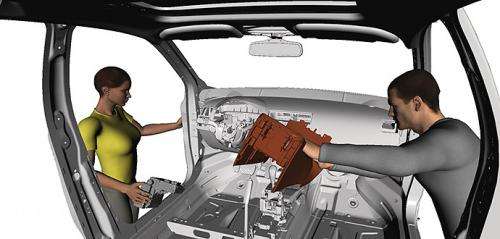Avoid work pain by using computer models of humans

Most of us suffer from work related pain at some time. It is estimated that 70% of the working population are affected by problems with muscles or the skeleton in the Western World. Ali Keyvani wants to improve the health for operators in the automotive industry by creating computer models based on human movements. He now presents his thesis "Structuring and use of motion data for computer manikin work task simulations".
Today, it is common to virtually build and simulate different elements of production lines including robots, machines, transfer belts, and other tools. However, one important element is usually missing in these simulation models: the humans themselves. Ali Keyvani focuses his research on operators, the humans in the factory, and explains more.
Work related pain is caused by several reasons such as prolonged static work and non-suitable posture or motions. These disorders can be greatly avoided if work task postures and motions can be simulated and studied already in the product development phase. Computer evaluations make it possible to detect potential deficiencies in advance.
Simulation of humans is rather a new trend called digital human modeling (DHM). There are some computer programs available and their purpose is to simulate and analyze human motions in 3D environment. Ali proposes different methods to improve the performance of such tools in work task simulations.
"The DHM-tools used today have weaknesses. They are time consuming and the resulted motions are still far from looking natural. Most of them use computational models for human motion simulation. Despite considerable progress, these models are still lacking efficiency and creditability when it comes to ordinary but complicated motions such as walking, turning, etc. My research offers a database-assisted model which can simulate these ordinary motions and therefore increase the usability of today's DHM tools. The presented model uses recorded motions from real humans to generate a natural and smooth motion. The recorded human bananas are first structured properly in a motion database, and are later used by a simulation engine. Also, this model presents a new method to analyze simulated motions and to correlate the results to the epidemiological data," says Ali Keyvani.
Ali has been part of a team in the project called CroMM. The project aims to develop an easy to use and automated simulation and visualization tool which enable industry to predict, visualize and evaluate the musculoskeletal burden on operators. Ali's contribution is within the evaluation scope. His results will lead to that the DHM tool can perform faster, easier and better.
Besides the technical skills Ali has achieved, other experiences have also enriched his PhD studies.
"For me, doing PhD studies in an international environment far from my home country was an extremely valuable experience. Meeting people with different cultures and the chance to attend international conferences brought new insights and opened my eyes to the world of global collaborations, hard efforts and competitive challenges. Although a PhD project is usually individual, it provides excellent opportunities for practicing teamwork and raises the level of awareness about state of the art through courses, workshops, and conferences."
More information: "Structuring and use of motion data for computer manikin work task simulations": publications.lib.chalmers.se/p … ork-task-simulations
Provided by Chalmers University of Technology



















